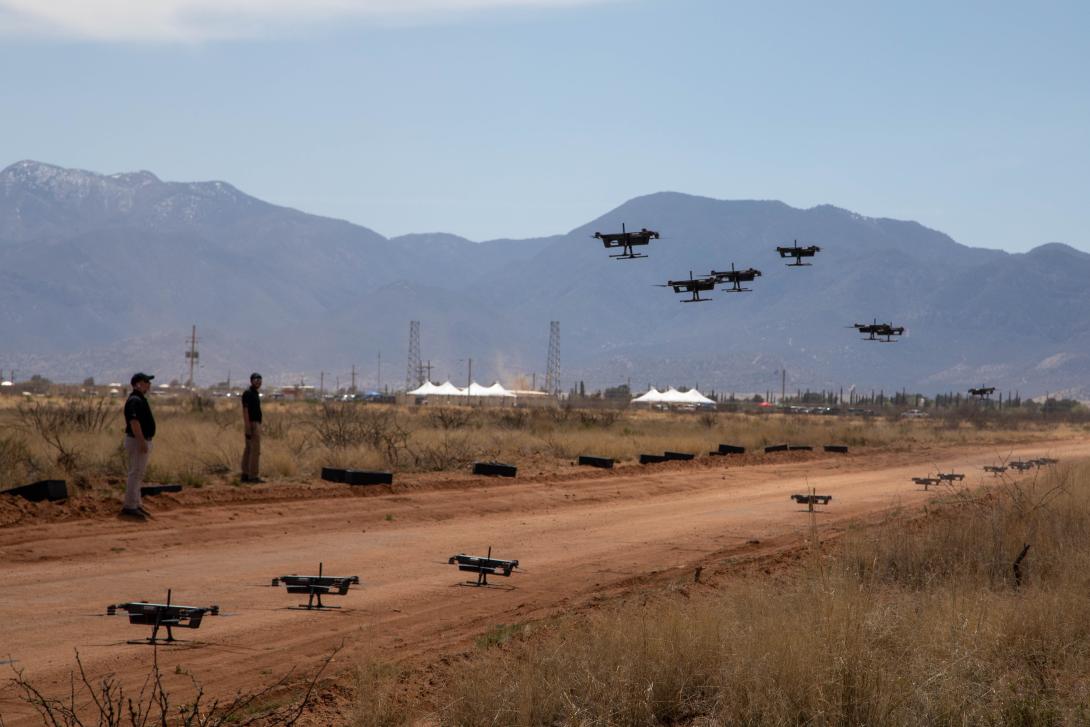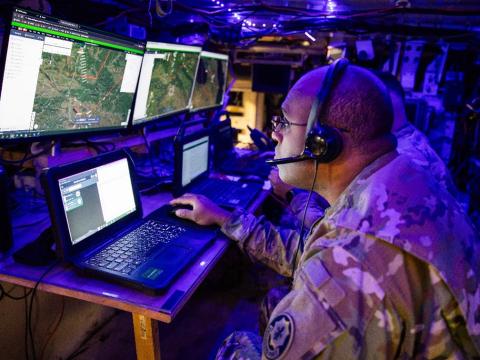U.S. Army To Explore ISR Drone Swarms This Year
The U.S. Army will assess cutting-edge capabilities for swarming, medium-sized unmanned aerial systems during the Vanguard 2024 exercise at Fort Huachuca expected to take place September 8-21. The autonomous aircraft will be capable of alerting humans to high-priority threats.
Vanguard will be the third experimental exercise this year during which the Army will explore new intelligence, surveillance and reconnaissance (ISR) and electronic warfare capabilities. Andrew Evans, who leads the Army’s ISR Task Force, describes Vanguard as a risk reduction event for the intelligence enterprise. "It’s a nonkinetic range, meaning we’re not going to fire munitions there. But we’re going to experiment with sensors, with electronic warfare capabilities, potentially with cyber capabilities, with integration to the joint force, with moving data, and making sense of it on the PED [processing, exploitation and dissemination] side.”
The service’s intelligence enterprise will also assess new capabilities at Project Convergence, February 23-March 20, and at Arcane Thunder, expected to take place in the August time frame. Arcane Thunder will include a second multidomain task force in Europe and will demonstrate high altitude sensing and the architectures that support “moving data rapidly across an entire continent,” Evans said.
“And then at Vanguard, we’re going to introduce some new capabilities that I think will be very exciting, including how we put sensors on launched effects, how we do autonomy and swarming, and the role of ISR with unmanned systems, how we make all of our systems talk to each other to ensure that we have a full convergence of sensors across the battlefield,” Evans reported in a recent interview.
He declined to discuss specific platforms or vendors, in part because source selection is still underway, but he did describe the aircraft as “medium size, unmanned systems that have the ability to detect and prioritize threats autonomously and reorient sensors, including thickening, let’s say, the sensing layer.”
The unmanned aircraft will be capable of alerting their human teammates to high-priority threats that require attention. If a priority threat is discovered, the drones can alert a human “wing man” and then autonomously “apply multiple sensors to that same problem set,” Evans said.
“We will be working with a number of industry partners to deliver those capabilities, experiment with some of the high TRL [technology readiness level] capability that they have, and then demonstrating that to the partners that are there, not only inside intel, but across the joint force, Special Operations Command and other users,” he added.
The ISR Task Force serves three essential functions: act as a voice for users who need new capabilities, accelerate those capabilities to the field, and help align budget resources and strategy. The task force helped develop the Army Intelligence Modernization Strategy, which was published last year, to pivot from the war against terrorists to larger-scale warfare against near-peer or peer competitors.
That strategy includes a “bridge” for airborne ISR that provides shorter-term capabilities until the service can deploy the High Accuracy Detection and Exploitation System (HADES), which will fly at higher altitudes than current ISR aircraft, allowing sensors to reach farther. The Army places a high priority on developing deep sensing capabilities for future conflicts.
During a roundtable discussion with reporters late last year, Brig. Gen. Ed Barker, Army program executive officer for intelligence, electronic warfare and sensors, said HADES will provide the “situational interchain for really targeted and long-range precision fires.”
The bridge to HADES includes two interim ISR aircraft known as ARTEMIS, the Airborne Reconnaissance and Target Exploitation Multi-Mission Intelligence Systems, and ARES, or Airborne Reconnaissance and Electronic Warfare System.
“There’s what I’ll describe as an insatiable demand for airborne ISR collection capability across all the combatant commands. We hear from them on a weekly basis about needing more, and the Joint Staff being unable to provide more due to capacity limitations. The Army has a part to play in that as a force provider, so we developed a strategy early on that we needed to modernize our airborne portfolio,” Evans offered. “But at the same time that we were modernizing, we could not walk away from the near term or that sort of the day-to-day demand.”

There’s what I’ll describe as an insatiable demand for airborne ISR collection capability across all the combatant commands.
Beginning next year, the Army will have six modernized bridge aircraft deployed, conducting collection operations around the globe. They will provide lessons learned for HADES. “Our bridge program is actually delivering modernized intelligence capability through some creative contracting strategies where we leverage industry to assume risk. And we deliver near-term capability to combatant commanders that they can use for satisfying collection requirements, but we can also use to inform the way we build our future programs,” Evans explained.
The Army has “generated tremendous momentum” behind four flagship ISR efforts: HADES, Terrestrial Layer System, Tactical Intelligence Targeting Node (TITAN), and the service’s integrated data platform. “We are very proud of these four major efforts. They have moved the Army intel enterprise into a multidomain-ready posture, and they are fully aligned with where we’re going in joint warfighting concepts,” Evans stated.
Service officials expect a couple of major accomplishments this year. “Soon there’ll be a down select on which vendor will provide our TITAN capability for the Army. That’s a big announcement that will be upcoming,” Evans said, suggesting the announcement should come by April. “In the fourth quarter of 2024, we will make a selection on which vendor will build the back of the HADES aircraft, so all of the system integration.”
In some other areas outlined in the strategy, Evans allows, the service is just beginning to explore the possibilities. “I think an example of that is how do we best implement machine learning and artificial intelligence into our process at all echelons? How do we do things like reduce the human cognitive burden in the exploitation phase? How do we use machines to offset human capital? And then how do you build trust into that? That’s obviously a new emerging area.”
He suggests that artificial intelligence (AI) may apply to processing, exploitation and dissemination. “If you look at PED models today, they’re very human-centric and require an analyst looking at a lot of sensor data, and trying to make sense of all of it. I would think what you can find with AI and machine learning is that you can allow the machine to point the human towards what is most important, and we maybe see that in the world of automatic target recognition, so ATR algorithms. We might see it in the world of [signals intelligence], in terms of signal identification and decomposing signals to try to give the analyst something to look at.”
Integrating AI onto sensors also is an option. “If you put AI algorithms on a sensor itself, you’re going to reduce the amount of data that you need to push back to somebody doing the analysis on that data. And that matters when you’re in environments where you have denied or intermittent or limited communications,” Evans explained. “Today, we sort of operate like vacuum cleaners, and we’ll suck down everything we can. But tomorrow in the next fight, we may have very limited bandwidth in which to pull it down.”
Now the task force is poised to help prepare the ISR budget for 2026. “This spring, we’ll be spending time building and defending the request to protect those programs that I just mentioned. In the Army, you know, we always say that innovation is easy. Protecting innovation, defending it over multiple years on a budget is much, much more difficult,” Evans declared.





Comments